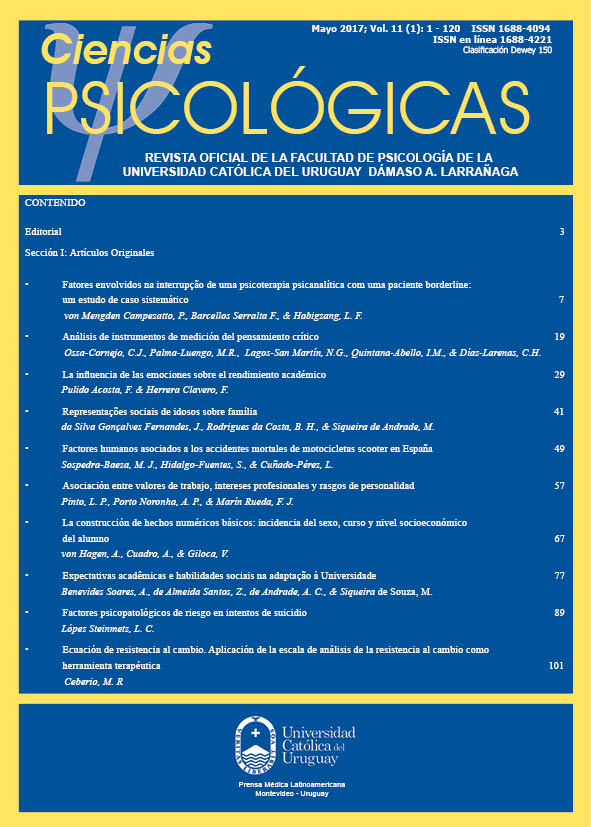ASSOCIATIONS BETWEEN WORK VALUES, PROFESSIONAL INTERESTS AND PERSONALITY TRAITS
DOI:
https://doi.org/10.22235/cp.v11i2.1347Keywords:
psychological assessment, work values, professional guides, personality traitsAbstract
This study aimed to investigate associations between vocational interests, personality traits and work values. 281 students participated, with a mean age of 23.97, from business administration, psychology, philosophy and theology, of the state of São Paulo. Three instruments (Scale Work Values Assessment, Search Quiz Self-Addressed and Battery Personality Factor) were use. The results indicated that the social responsibility and management factors explained the interests Realistic, Social, Conventional and Artistic, with an explained variance between 2% and 18%. With respect to personality traits as predictors of working values, results showed values between 9% and 33%, with ‘Competence’ as the most present facet in the models. The results are discussed according to the literature.
Downloads
References
Berings, D., Fruyt, F. D., &Bouwen, R. (2004). Work values and personality traits as predictors of enterprising and social vocational interests. Personality and Individual Differences, 36, 349-364.doi:10.1016/S0191-8869(03)00101-6
Chernyak-Hai, L., &Tziner, A. (2016). The “I believe” and the “I invest” of Work-Family Balance: The indirect influences of personal values and work engagement via perceived organizational climate and workplace burnout. Journal of Work and Organizational Psychology, 32, 1-10.doi: 10.1016/j.rpto.2015.11.004
Consiglio, C., Cenciotti, R., Borgogni, L., Alessandri, G., & Schwartz, S. H. (2016). The WVal: A New Measure of Work Values. Journal of Carreer Assessment, 22, 1-18.doi: 10.1177/1069072716639691
Duffy, R. D., Borges, N. J., &Hartung, P. J. (2009). Personality, Vocational Interests, and Work Values of Medical Students. Journal of Career Assessment, 17(2), 189-200.doi: 10.1177/1069072708329035
Furnham, A., Petrides, K. V., Tsaousis, I., Pappas, K., &Garrod, D. (2005). A cross-cultural investigation into the relationships between personality traits and work values.The Journal of Psychology: Interdisciplinary and Applied, 139(1), 5-31.
Hair, J. F., William, B., Babin, B., & Anderson, R. E. (2009).Análise multivariada de dados (6ª ed). Porto Alegre: Bookman.
Holland, J. L., &Rayman, J. R. (1986). The SDS as an Innovation. In B, Walsh, & S. H. Osipow (Eds.), Advances Vocational Psychology (vol. I – The Assessment of Interests) (55-81). London: Lawrence Erlbaum Associates.
Leuty, M. E., & Hansen, J. C. (2011). Evidence of construct validity for work values.Journal of Vocational Behavior, 79, 379-390.doi: 10.1016/j.jvb.2011.04.008
Leuty, M. E., & Hansen, J. C. (2013). Building Evidence of Validity: The Relation Between Work Values, Interests, Personality, and Personal Values. Journal of Career Assessment, 21(2), 175-189.
doi: 10.1177/1069072712466714
Nunes, C. H. S. S. Hutz, C. S., & Nunes, M. F. O. (2010). Bateria Fatorial de Personalidade (BFP): Manual técnico. São Paulo: Casa do Psicólogo.
Pinto, L. P., & Noronha, A. P. P. (2014). Escala para Evaluación de los Valores de Trabajo (EAVT). Documento técnico no publicado. Campinas: Universidade São Francisco.
Primi, R; Mansão, C. M.; Muniz, M., & Nunes, M. F. O. (2010). SDS- Questionário de Busca Autodirigida. Manual Técnico da versão brasileira. São Paulo: Casa do Psicólogo.
Rottinghaus, P. J., &Zytowski, D. G. (2006). Commonalities between adolescents’ work values and interests.Measurement and Evaluation in Counseling and Development, 38, 211-221.
Rounds, J., & Armstrong, P. I. (2014). Integrating values and interests for career counseling. In M. Pope, L. Y. Flores, & P. J. Rottinghaus (Eds.), The role of values in careers (pp. 101–113). Greensboro, NC: Information Age.
Rounds, J. B., & Armstrong, P. I. (2005).Assessment of needs and values. In S. D. Brown & R. W. Lent (Eds.), Career development and counseling (pp. 305-329). New York: John Wiley.
Savickas, M. L. (1999).The psychology of interests. In M. L. Savickas& A. R. Spokane (Eds.), Vocational interests: Meaning, measurement, and counseling use (pp. 19-56). Palo Alto, CA: Davies-Black.
Super, D. E. (1957).The psychology of careers. New York: Harper & Row.
Super, D. E. (1973).The Work Values Inventory.In D. G. Zytowski (Ed.), Contemporary apporaches to interest measurement (pp.189-205). Minneapolis: Univerity of Minneapolis Press.
Super, D. E. (1995). Values: their nature, assessment and practical use. In D. E. Super, & B. Sverko (Eds.), Life roles, values, and careers: international findings of the Work Importance Study (pp.3-21). San Francisco: Jossey-Bass Publishers.
Sverko, B., Barbarovi, T., &Sverko, I. (2008).Assessment of values and life salience. In J. A. Athanasou, & R. Van Esbroeck (Eds.). International Handbook of Career Guidance (pp. 539-564). Dordrecht: Springer.
Sodano, S. M. (2011). Integrating work and basic values into the Spherical Model of Interests. Journal of Vocational Behavior, 78, 1-10.doi:10.1016/j.jvb.2010.09.004
Sortheix, F. M., Chow, A., &Salmela-Aro, K. (2015). Work values and the transition to work life: A longitudinal study. Journal of Vocational Behavior, 89, 162-171.doi: 10.1016/j.jvb.2015.06.001
Tien, H. L. S. (2011). An exploration of adult career interests and work values in Taiwan.Asia Pacific Education Review, 12, 559-568.
Vinken, H. (2007). New life course dynamics? Career orientations, work values and future perceptions of Dutch youth. NordicJournalofYouthResearch, 15(1), 9-30.
















